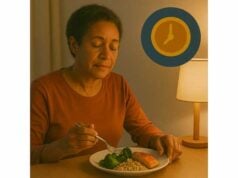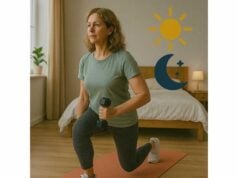
Stress touches every system we care about for long life—sleep, cardiovascular health, cognition, and emotional balance. What steals years is not a single hard day but the pattern of chronic strain, especially when evenings stay busy and the brain never gets a proper off-ramp. Resilience is the practical skill of downshifting on purpose: turning worry into plans, setting boundaries on stimulation, and training the body to recover faster. This guide shows how to break the stress–sleep loop and build reliable recovery in the hours that matter most. If you want the wider context of how nightly restoration supports healthspan, see our pillar on sleep, stress, and recovery strategies. Then return here to pick one change for your mind and one for your body this week. Aim for consistent, repeatable steps—because small recovery done daily compounds more than rare big resets.
Table of Contents
- The Stress and Sleep Loop: Why Evenings Matter
- Cognitive Techniques: Reframing, Worry Time, and Journaling
- Breathwork and HRV Training for Faster Wind Down
- Movement Snacks, Nature, and Sunlight for Resilience
- Micro Recovery Breaks at Work and at Home
- Designing a Personal Evening Recovery Routine
- Tracking Progress: Sleep, Mood, and HRV Trends
The Stress and Sleep Loop: Why Evenings Matter
Stress and sleep reinforce each other. When the day runs hot—meetings, messages, decisions—the sympathetic nervous system stays elevated. That state primes the brain to monitor, not to recover. At night, the same vigilance makes it harder to fall asleep and easier to wake up at 2–3 a.m. After a choppy night, the next day brings lower patience and a stronger stress response. The loop tightens.
Evenings are the leverage point because they control two drivers of restorative sleep:
- Circadian timing. Your internal clock expects light, movement, and social engagement by day; it expects dim, quiet, and routine by night. If the evening stays bright and stimulating, melatonin rises later, slow-wave sleep shortens, and REM is clipped in the early morning.
- Homeostatic pressure and arousal. Mental load and emotional residue add “noise” that blocks the descent into deep sleep. Ruminative thought—replaying or rehearsing—acts like a background app that never closes.
To weaken the loop, match inputs to the time of day:
- Earlier: sunlight, movement, and complex tasks.
- Later: low light, simple decisions, short social closers, and practices that nudge the autonomic system toward parasympathetic dominance.
Two patterns help most people in midlife:
- A clean off-ramp. A defined 60–90 minute wind down that removes friction: a brief plan for tomorrow, a low-stakes connection, and a single calming practice.
- Predictable timing. Bedtime and wake time kept within a 60-minute window, plus an earlier dinner. Regularity often outperforms chasing extra hours when sleep is light.
Consider stress as cumulative load and recovery as capacity. You can lower load (fewer late decisions, fewer screens) and raise capacity (breathwork, light exposure, movement). The following sections translate those levers into specific steps with measurable outcomes—so you can confirm what actually works in your life.
Cognitive Techniques: Reframing, Worry Time, and Journaling
When stress bites at night, the story in your head matters as much as the events on your calendar. Cognitive tools reduce mental load so the body can do the work of recovery. You do not need therapy-level depth to benefit. Ten focused minutes, used well, can shift the entire night.
Reframing in three steps (5 minutes).
- Name the thought in concrete terms (“If I miss the deadline, I’ll lose the client.”).
- Check the evidence and cost. What are the real risks? What is controllable today? What is the cost of carrying this thought at midnight?
- Write one adaptive alternative. “The client is late with feedback; I’ll send a summary and offer two options by 10 a.m.” The goal is not forced positivity but a more accurate, actionable frame.
Scheduled Worry Time (15–20 minutes, late afternoon).
Give your solver-brain its own sandbox earlier in the day. Set a timer. List active worries in bullet form, then match each to a next step, a person, or a date. When worries pop up at 10 p.m., remind yourself: “Booked for 5:30 p.m. tomorrow.” Paradoxically, boundaries make you more effective; you return to the sandbox fresh and calmer.
Journaling for sleep (8–10 minutes, evening).
Use a two-column page: Left = Facts, Right = Moves
- Left: “Presentation on Friday; 20 slides; data cleanup needed.”
- Right: “Block 45 minutes at 9 a.m. to clean data; email Linda for Q3 revenue.”
Finish with a brief closure: one line of gratitude (specific), one small kindness you will offer tomorrow (call a friend, thank a colleague). This “close-the-day” format tells the brain that business is contained. It also provides a head start for the morning, lowering next-day reactivity.
Ruminations at 2–3 a.m.? Use single-line capture.
Keep a notepad by the bed. Write one line (“Schedule roof repair quote”). Close the notebook. If the thought returns, repeat the same line; the brain learns that the container is trustworthy.
Cognitive tools pair well with behavioral structure.
If you struggle with long-term insomnia or want a method to rebuild sleep efficiency, consider a brief, structured course grounded in behavioral principles. A practical guide is available at CBT-I basics for midlife sleep—use it to align your thinking work with timing and routines.
Common pitfalls to avoid
- Endless lists without decisions. Always match items with a tiny next step.
- Late, heavy conversations disguised as “connection.” Keep evening talk low-stakes.
- Overshooting: more than 20 minutes of worry time often becomes rumination. Cap it.
Aim for consistency over depth. A short, reliable cognitive ritual each evening will do more for resilience than occasional marathon sessions.
Breathwork and HRV Training for Faster Wind Down
Your autonomic nervous system speaks a physiological language. You can influence it quickly through the breath–heart link, nudging the body toward a recovery state before bed or between stressful tasks. Two approaches cover most needs: paced breathing and HRV biofeedback.
Why it works.
As you slow and lengthen exhalations, the vagus nerve exerts more influence on the sinoatrial node, increasing heart rate variability (HRV). Higher HRV reflects flexible, resilient control—your system can shift from effort to recovery more easily. Short sessions train this flexibility so it shows up when you need it.
Paced-breathing protocols
- 4–6 downshift (5–10 minutes): Inhale 4 seconds, exhale 6 seconds, no breath holds. Ideal for evening wind down and middle-of-the-night wakeups.
- Box breathing, light (3–5 minutes): Inhale 4, hold 4, exhale 4, hold 4. Use earlier in the day for focus; avoid right before bed if holds feel activating.
- Coherent breathing (10 minutes): Breathe ~5–6 breaths per minute with smooth transitions; imagine airflow at the heart level.
HRV biofeedback (10–15 minutes, 3–5 days/week).
With a simple sensor or camera-based app, you breathe at your resonance frequency (often 4.5–6.5 breaths/min). The device shows real-time HRV; you adjust until the waveform becomes smooth and regular. Over weeks, this training can raise baseline HRV and lower perceived stress during the day, making evenings easier.
Where to place sessions
- During the day: before a loaded meeting; after an upsetting call; pre-commute; midday reset.
- Evening: 15–30 minutes before lights-out as part of your wind down.
- Night wakes: 2–3 minutes of 4–6 breathing, eyes closed, in low light.
Practical tips
- Posture: Sit or recline comfortably; keep shoulders relaxed.
- Nasal bias: Gentle nasal breathing humidifies and slows airflow.
- Step-down approach: If you start anxious, begin with 3 minutes at a slightly faster pace, then slide into 4–6.
- Make it portable: Pair a short breathing set with a trigger habit (after brushing teeth; after parking the car).
Who benefits most
- Busy professionals who need fast state shifts without equipment.
- Caregivers who must re-enter sleep after nighttime tasks.
- People with “tired-and-wired” evenings—mentally exhausted but physically keyed up.
If you want a ready-made sequence and options for simple devices, skim our practical overview at breathwork and HRV basics. Start with five minutes daily for one week; if your evening heart rate and time-to-sleep improve, keep going. Ten reliable minutes will beat an hour of inconsistent practice every time.
Movement Snacks, Nature, and Sunlight for Resilience
Stress is not only cognitive; it is metabolic. Muscles, vasculature, and mitochondria respond to movement and light in ways that directly support recovery. You do not need heroic workouts to notice a difference. A few well-placed movement snacks and light doses change the entire tone of the day.
Movement snacks that fit real life
- After-email reset (2–3 minutes): Stand, shoulder rolls, 10 squats to a chair, 10 calf raises, 30-second shake-out.
- Between calls (2 minutes): Wall push-ups, thoracic rotation, gentle neck mobility.
- Afternoon lull (5 minutes): Easy walk or step-ups; finish with a 20–30 second cold splash to face or wrists if alertness is low.
- Evening tension release (5 minutes): Slow hip flexor stretch, child’s pose, diaphragmatic breathing.
These short bouts reduce muscle guarding, improve circulation, and cut the edge off stress hormones without the heat and activation that intense late workouts bring.
Sunlight as a recovery tool
Morning and midday outdoor light set the circadian clock, lift mood, and make evening light less disruptive. Targets that work for most adults:
- Morning: 10–30 minutes outside, eyes receiving light (no sunglasses if comfortable), soon after waking.
- Midday: another 10–20 minutes, ideally tied to a short walk or social check-in.
- Afternoon: if your evenings drift late, add 10 minutes of late-afternoon light plus a brief climb of stairs to re-alert the system.
Nature exposure reduces cognitive load
Green and blue spaces lower perceived stress and rumination. If access is limited, micro-nature still helps: an outdoor balcony, a courtyard loop, or even tending indoor plants near a bright window. Combine a five-minute walk with one quick call; you will have light, movement, and connection in a single block.
Activity timing and sleep
Vigorous training raises core temperature and alertness. If intense exercise near bedtime leaves you wired, move it earlier and save evenings for gentle mobility. If evenings are your only window, finish 2–3 hours before lights-out and extend your wind down.
Build a simple weekly scaffold
- Daily: morning light + one five-minute movement snack before lunch.
- 3 days/week: 20–40 minutes of moderate activity (walks, cycling, swimming).
- 1–2 days/week: resistance training for major muscle groups.
- Every day: a short, easy wind-down stretch.
For circadian-friendly timing ideas that dovetail with daytime light, see morning light and evening darkness tips. One week of earlier light and small movement doses is often enough to notice deeper first-half sleep and steadier mood.
Micro Recovery Breaks at Work and at Home
Recovery cannot wait until vacation. The nervous system resets in seconds to minutes if you give it the chance. Micro-breaks prevent stress from compounding into evening overload, and they do it without costing much time.
What counts as a micro-break?
A purposeful ≤10-minute pause that reduces cognitive or emotional load. Think of it as a pit stop to refuel attention and soften muscle tension.
Three micro-break archetypes
- Physiological reset (1–3 minutes): Slow breathing (4–6), face or wrist rinse with cool water, step outside for bright light.
- Attention shift (2–5 minutes): Look at a distant view (rest your near-focus muscles), stand and stretch, or do a brief “body scan” from feet to head.
- Social micro-dose (2–5 minutes): Send one gratitude note; voice a quick “great job on X today” to a teammate; confirm a plan with a friend.
Cadence that works
- Morning: one reset after your second or third work block.
- Midday: 5–10 minutes outdoors—walk the block; no headphones.
- Afternoon: a brief move-and-breathe combo before the last push.
Protect the quality of breaks
- Leave the chair. Change posture to change physiology.
- Avoid high-friction tasks (news, heated threads) that fill the brain with fresh content.
- Use a repeatable cue. A water bottle refill, calendar chime, or the end of a meeting.
Home version
- Between chores, lean against a wall and breathe 10 slow cycles.
- After caregiving tasks, wash hands with warm water deliberately, noting temperature and contact—simple sensory anchors interrupt rumination.
- When you transition to evening, take a two-minute balcony break to mark the shift from work to home.
If you tend to skip breaks
Bundle a micro-break with something you already do: bathroom trips (add a 60-second stretch), coffee refill (add 90-second breathing), or file save (stand and roll shoulders while it syncs). You are not “losing time”; you are preventing later errors and faster burnout.
For deeper calm-building practices, see mindfulness approaches that settle the HPA axis. Start tiny. One excellent two-minute reset per hour beats three distracted “breaks” that are just more screen time.
Designing a Personal Evening Recovery Routine
A good evening is engineered, not improvised. The best routines are short, specific, and repeatable. They lower arousal, protect circadian timing, and make it easy to fall back to sleep if you wake.
Build your 60–90 minute template
- T–90: Dim the house. Set tomorrow’s top three tasks on a card.
- T–60: Light co-presence—quiet chat, a short walk, or low-stakes TV (no cliffhangers).
- T–30: Warm shower or bath to trigger cooling; then a brief stretch.
- T–20: Breathing or HRV practice (4–6 or coherence).
- T–10: Devices docked; lights low and warm; read a paper book or do a short gratitude entry.
- Lights-out: Room cool, dark, and quiet; eye mask and earplugs as needed.
Environmental guardrails that matter
- Light: Reduce brightness, not just blue content. Table lamps beat overhead glare. If you need a night light, keep it low and warm.
- Temperature: Slightly cool rooms settle the body faster; add breathable layers.
- Noise: Use steady, low-volume sound if the environment is unpredictable.
Food, alcohol, and late tasks
- Aim for the final full meal 2–3 hours before bedtime.
- If you drink, finish 3–4 hours before lights-out and expect lighter sleep; plan a quieter next morning.
- Skip high-stakes emails and planning after your wind down starts. Decision fatigue belongs to the daytime.
If awakenings are your bottleneck
Keep a night wake kit: water, notepad, lip balm, and a card with your 2–3 minute breathing pattern. Avoid clocks and bright light. If worry spikes, write a one-line capture; repeat breathing for two minutes; give sleep a second chance. If not sleepy after ~20 minutes, read something low-stakes in very low light and try again.
Make the routine yours
- Live with kids? Shorten to 30–45 minutes and protect only two pieces at first (device docking and breathing).
- Shift worker? Keep the structure but align it to your biological evening (the 90 minutes before your main sleep).
- Sensitive to screens? Double down on light hygiene; review timing ideas at evening screen strategies.
The goal is not a perfect ritual but a reliable one. It should be easy on tired nights and flexible on busy ones. Track how quickly you fall asleep, how often you wake, and how you feel at 10 a.m. Adjust one element per week until those markers improve.
Tracking Progress: Sleep, Mood, and HRV Trends
Without feedback, even good routines drift. You do not need a lab—just a light-touch scorecard that shows whether your recovery is moving in the right direction.
Pick a simple dashboard (daily, 4 weeks)
- Sleep quality (0–10): On waking, rate depth and refreshment.
- Mood/stress (0–10): Midday, rate calm and capacity to focus.
- Bedtime and wake time (± minutes): Track regularity more than exact time.
- Optional if you already use devices: resting heart rate (RHR) and HRV overnight, plus snoring minutes if relevant.
What to look for
- RHR: Gradual downward trend and a smooth overnight decline suggest better recovery. Elevated, flat curves after late meals, heavy workouts, or alcohol tell you exactly what to change.
- HRV: Compare you to you. Rising weekly averages after breathwork or earlier light indicate improved flexibility. A single dip is noise; 3–5 nights in a row are a signal.
- Subjective scores: More mornings at 6–8/10 and fewer days below 4/10 mean you are on track.
Run clean A/B tests
- Week 1: Add morning light + one movement snack before lunch.
- Week 2: Install a 60-minute wind down with breathing.
- Week 3: Shift dinner earlier and dock devices 60 minutes before bed.
- Week 4: Add a midday nature walk or social micro-break.
Change one variable per week; keep the rest constant. Judge by weekly averages, not single nights.
Use wearables wisely
Treat sleep stages and readiness scores as directional, not diagnostic. Trend lines beat nightly labels. If the data disagree with your lived experience for more than two weeks, prioritize how you feel and adjust the plan to your context.
When to seek extra help
- Persistent insomnia (≥3 nights/week for ≥3 months).
- Loud snoring with witnessed pauses, morning headaches, or unrefreshing sleep.
- Mood that stays low most days for two weeks, or loss of interest in things you used to enjoy.
- Daytime sleepiness that affects safety.
If you lean on devices, skim a concise overview at what to track and what to ignore. The only metric that truly matters is better days. Use the numbers to support that goal—not to create a new source of stress.
References
- Loneliness and sleep: A systematic review and meta-analysis 2020 (Systematic Review and Meta-analysis)
- Cognitive Behavioral Therapy for Insomnia (CBT-I): A Primer 2022 (Review)
- Methods for Heart Rate Variability Biofeedback (HRVB) 2023 (Methodological Review)
- “Give me a break!” A systematic review and meta-analysis on the efficacy of micro-breaks for increasing well-being and performance 2022 (Systematic Review and Meta-analysis)
- Time spent in outdoor light is associated with mood, sleep, and circadian-related outcomes 2021 (Observational Study)
Disclaimer
This article provides general education about stress resilience, sleep, and recovery. It is not a substitute for personal medical advice, diagnosis, or treatment. If you experience persistent insomnia, daytime sleepiness that affects safety, severe anxiety or depression, or symptoms of a sleep disorder, seek professional care. Discuss new routines or therapies with your clinician, especially if you manage cardiovascular, respiratory, neurological, or mental health conditions.
If this guide helped you, please consider sharing it on Facebook, X, or your preferred platform, and follow us on social media. Your support helps us continue creating careful, evidence-based resources for our community.










